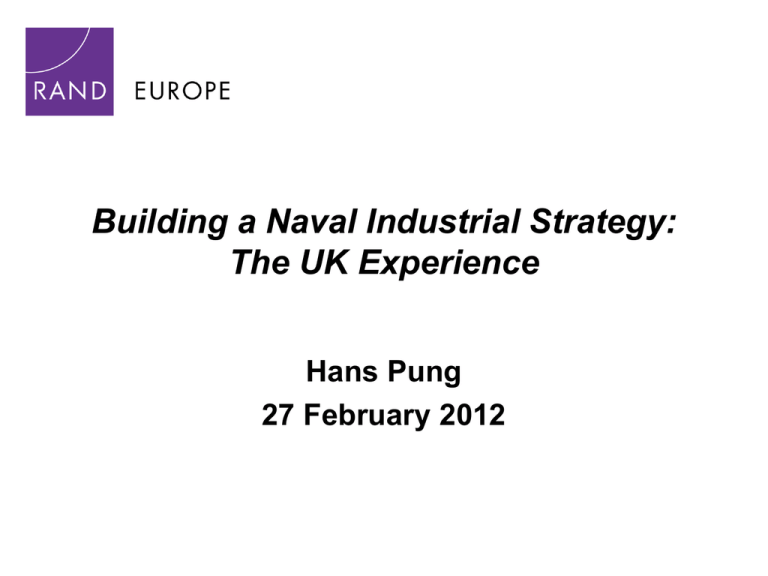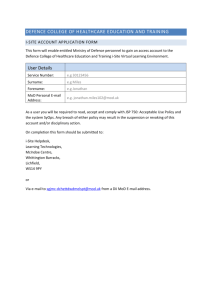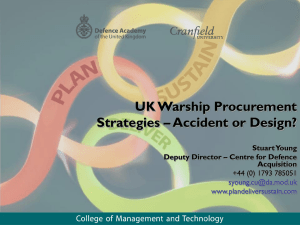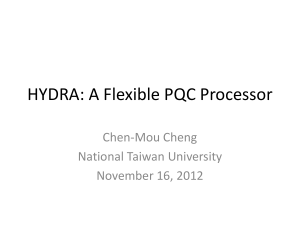Hans Pung, RAND Europe
advertisement

Building a Naval Industrial Strategy: The UK Experience Hans Pung 27 February 2012 Agenda • Background—UK industrial policy post-1998 • Defence Industrial Strategy (DIS): 2005-2012 – Maritime Long Term Partnering – Emerging Challenges • Current UK Defence Industrial Policy – Key Themes – Maritime Impact • Lessons and Implications for Canada UK Experience / Slide-2 RAND has undertaken a number of studies for the UK MOD examining maritime issues UK Experience / Slide-3 Following the 1998 Strategic Defence Review, UK MOD looked to push acquisition risk to key suppliers • Major “Smart Acquisition” procurement review • MOD adopts “eyes-on, hands-off” approach – Followed years of gradual decline of MOD technical ability • Focus on competition – Where this is possible • Preference for fixed-price contracts – Minimize risk to MOD UK Experience / Slide-4 This approach revealed some unintended consequences • Competition focus encouraged new market entrants – These did not always have domain knowledge – Contract awards did not focus on industrial capability • Fixed price contracts did not reduce risk to MOD – No redundancy in the event of contract default – Industry restructuring led to less risk appetite amongst big firms • Increased realisation that MOD required greater engagement/knowledge in defence procurement UK Experience / Slide-5 The Astute submarine project provides a good example of these tensions • Contract awarded in 1997 to GEC Marconi – Limited experience in nuclear submarine construction – Later bought out by BAE Systems • Initial fixed-price contract for 3 boats – Contract later renegotiated in 2003 • A number of factors led to project overruns – Poor initial estimating – Lack of experienced personnel UK Experience / Slide-6 The 2005 Defence Industrial Strategy provided clearer policy regarding naval procurement activity • Reversed previous policy that all • • • • shipbuilding would be carried out in UK Commitment to sustain key capabilities with a core workload Confirmed that a minimum ability to design build, integrate, support and upgrade complex ships in the UK must be retained More sophisticated procurement strategies will be employed –but competition remains where effective (e.g. for equipment) Industry consolidation expected/required UK Experience / Slide-7 DIS developed a model to determine on-shore capability requirements In summary: • On-shore concept design for all vessels • On-shore build of complex warships • On-shore inservice support for all vessels UK Experience / Slide-8 DIS also lead to a closer and strategic relationship between MOD and the shipbuilding industrial base • 15-year strategic partnering agreement between MOD and BVT (JV between VT Shipbuilding and BAE Systems) agreed in 2007 and finalised in 2009 – Carrier contract signed two days after ToBA Heads-of-Terms was agreed – BAE later exercised option to purchase VT maritime business • Similar agreement between MOD and Babcock Marine agreed in 2010 UK Experience / Slide-9 The BVT (later BAE) ToBA placed a number of commitments on both MOD and industry . . . MOD • 15 year exclusivity on specified BVT • Merge ex BAE/VT/FSL naval Ship build and support businesses to deliver programmes integration savings; • Sustain Key Industrial Capabilities transform new business to generate efficiency savings (via workload or funding) • Independent benchmarking • Underwrite transformation and to achieve upper-quartile initial rationalisation costs performance • Maintain competition in Supply Chain UK Experience / Slide-10 . . . but also promises a number of benefits to both MOD • £350-900m savings over 15-year BVT • Long-term certainty of term of ToBA • Assurance of Key Industrial Capabilities to meet future demand • Rationalised shipbuilding business fit for purpose • High performance of key shipbuilding partner workload • Visibility of MOD forward planning • £230m annual revenue throughput UK Experience / Slide-11 However, the ToBA did not prevent a large production ‘gap’ in UK shipbuilding plans UK Experience / Slide-12 Although, costs of the BAE ToBA were a key factor in deciding to build two aircraft carriers UK Experience / Slide-13 When is a Long Term Partnering Agreement an appropriate government procurement strategy? • Transformation or rationalisation of a business sector • • • • • • – “Right sizing” of an industrial capability Need to retain: – industrial capability – strategic capability to maintain freedom of action Competition is impractical Need for predictability in future workload Financial benefit from partnering and collaboration Government requirement to increase export potential Political & business imperative for such an approach UK Experience / Slide-14 In early February, the UK updated its (defence) industrial policy • Applies across the national security space • Commitment to open procurement when possible • Tempered by: – Operational advantage – Freedom of action UK Experience / Slide-15 Implications for the UK maritime industry • Too early to tell—paper is intentionally vague about • • • • specific sector strategies Open systems and modular design will be encouraged Industry may be reluctant to self-invest in new technologies Clear definition of Value-for-Money precludes any impact on socio-economic factors (employment, local impact, tax receipts, etc.) Rationale for ToBAs eroded UK Experience / Slide-16 Lessons for Canada • Long-term partnership agreements can leverage benefits for government and industry – Enterprise-wide resource management – Transparency of planning – Commitment to increased productivity • Facility and skills investment • Efficiency in operations but . . . • Strategy must align with wider government priorities • Commitments must be sustainable and funded • Funding is not a substitute for true capability UK Experience / Slide-17











